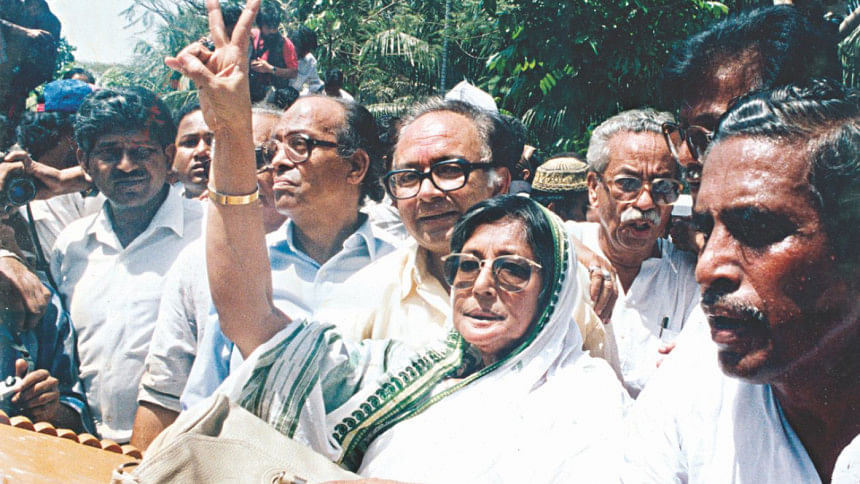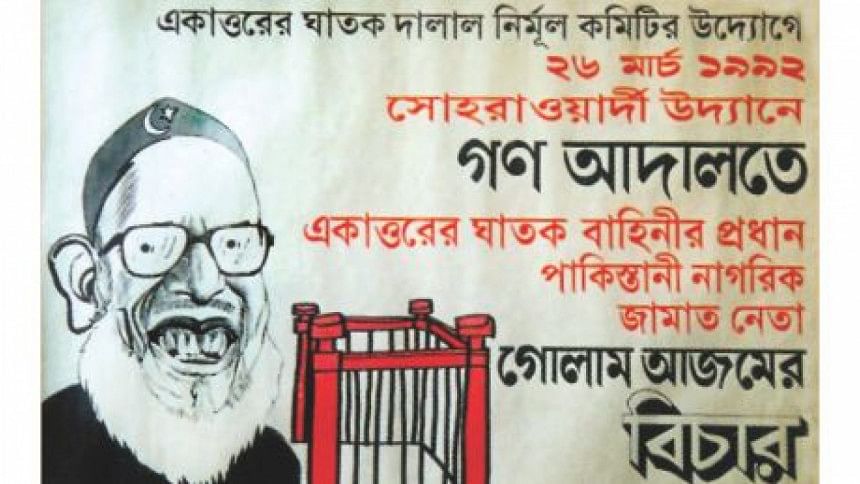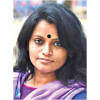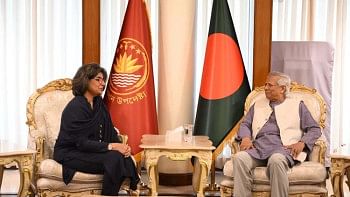GANO ADALOT

February, 2013. The nation saw a youth uprising challenging the verdict of a convicted war criminal, Abdul Quader Mollah, who was awarded life-term imprisonment by the International Crimes Tribunal (ICT) 2. Young people from all across the city joined the protest, demanding that he receive the death sentence. They chanted slogans: Jahanara Imamer rokto amader dhomonite (Jahanara Imam's blood flows through our veins), as they carried Shaheed Janani's portraits in their hands. Three years earlier, in March 2010, the International Crimes Tribunal had been formed and the trial of war criminals began. Jahanara Imam became a symbol of their movement. The youth stood united, imbued with the spirit of Shaheed Janani and her compatriots, who struggled to materialise the nation's demand for the trial of war criminals and collaborators of Pakistan army during 1971. It was through the Ekattorer Ghatak Dalal Nirmul Committee's Gano Adalot (People's Court) that the demand for the trial of war criminals was popularised. In its 24th year, we remember the role of the committee which sounded the wake-up call of justice against the perpetrators of the 1971 genocide.
It all began on December 29, 1991 when a report was published in a local newspaper that Ghulam Azam was elected the Amir of Jamaat- e-Islami at the party's shura meeting, the highest policy-making forum of the party. Ghulam Azam was the chief collaborator of the Pakistani occupation army who planned the systematic killing of innocent Bangalis and the best sons of this soil and the rape of two lakh women in 1971 Liberation War. Although his citizenship was revoked under the Collaborators Act, he had been leading the party from behind the curtain since he entered Bangladesh on July11, 1978 with a Pakistani passport. It was only natural that people would get enraged at the audacity of Jamaat-e-Islami for publicly declaring him the Amir of the party. In immediate protest, Muktijodhdha Sangsad's (Ahad-Aziz) Dhaka Metropolitan Unit brought out a rally in Dhaka demanding his exile from the country. On the same day, Ganotantrik Chhatra Oikyo held a protest rally on the premises of Dhaka University. There was also heated debate in the parliament on the issue of his citizenship. Political parties and student organisations started giving statements in daily newspapers, condemning the move of Jamaat.
Against this backdrop, on January 19, 1992, the Ekattorer Ghatak Dalal Nirmul Committee (Committee for Realisation of Bangladesh Liberation War Ideals and Trial of War criminals) was formed with 101 eminent citizens of the country. Freedom fighters, intellectuals, writers, journalists, artists, and cultural activists were among them. Shaheed Janani Jahanara Imam was made the convener of the committee. Among other organisers were Sector Commander Lieutenant Colonel(retd.) Kazi Nuruzzaman, Shahriar Kabir, Prof. Kabir Chowdhury and Sufia Kamal, to name a few. The committee demanded that Ghulam Azam be deported from the country by March 25 that year. Otherwise, a Gano Adalot (People's Court) would be set up on the 21st anniversary of our Independence (March 26) where he would be tried symbolically for committing genocide and crimes against humanity in 1971.
Prior to this, several initiatives were undertaken to try these war criminals which saw little success. Right after our Independence, the very first initiative for war crimes trial was taken not by the government but by citizens' groups. On December 29, 1971, only thirteen days after our victory in the war, Zahir Raihan, a noted writer and filmmaker, formed a commission to investigate the killing of the intellectuals. After his disappearance on January 30, 1972, the work of the commission stopped.

In 1972, the Collaborators Act was enacted to try the Bangladeshi collaborators. Under this law, 73 special tribunals were set up all across the country and 37,471 people were arrested before general amnesty was declared in November 30, 1972. Among the detained, trial of 2848 was completed. 752 of them were sentenced to different terms of punishment and the rest were freed. Under general amnesty, a total of 26,000 people were set free while the rest 11,000 had to stand trial. Unfortunately, the Collaborators Act was abolished on December 31, 1975 by the then Sayem-Zia government and these 11,000 people who were detained under this law were also set free.
Since it was not possible to try the Pakistani war criminals under the Collaborators Act, on July 20, 1973 the government enacted the International Crimes (Tribunals) Act and took an initiative to try the Pakistani war criminals who were detained in India. But unfortunately, on April 19, 1974, a MoU was signed in Delhi among the foreign ministers of Bangladesh, Pakistan, and India and accordingly, Bangladesh had to let go of the 195 notorious Pakistani war criminals as Pakistan assured to try them.
Years later, on March 21, 1981, Lt Col (retd) Kazi Nuruzzaman, Bir Uttam, a sector commander (sector 7) and the then Chairman of Bangladesh Muktijodhdha Sangsad, declared for the first time that they would try the war criminals in Gano Adalot. In his statement, he said: "If the government fails to try the war criminals, the Muktijodhdha Sangsad will try all the razakars and Al-Badrs including Ghulam Azam in Gano Adalot." But sadly, this could not be done because of the political situation of the country. Eleven years gone by before the Nirmul Committee brought this demand in the limelight.
When Nirmul Committee's statement was published in newspapers, it was met with huge support from the public. Many organisations such as Muktijoddha Sangsad (Mahfuz-Kabir), Shaheed Lieutenant Selim Mancha, Projonmo '71, Gram Theatre and many socio-cultural organisations expressed solidarity with the committee. Pro-liberation political parties and progressive student organisations expressed their support for the movement.
As it was by character a political movement, involvement of all political parties who believed in the values of our Liberation War was necessary to make it a success. The Nirmul Committee under the leadership of Jahanara Imam worked day and night to engage more people with the movement. On February11, with the representatives of 72 different organisations, Muktijuddher Chetona Bastobayon O Ekattorer Ghatak Dalal Nirmul Jatiyo Samonnoy Committee (National Coordinating Committee for the Realisation of Bangladesh Liberation War Ideals and Trials of Bangladesh War Criminals of 1971), also known as Shomonnoy Committee, was formed. After the formation of the Shomonnoy Committee, the movement got momentum and spread all across the country.
In order to foil the movement, Jamaat started spreading propaganda against the Nirmul Committe. On January 22, 1992, Matiur Rahman Nizami, the then secretary general of Jamaat-e-Islami, in a statement termed the members of the committee 'enemies of the constitution.' The Nirmul Committee responded to their comments through counter-statements. As the day of the 'trial' by Gano Adalot approached, Jamaat-e-Islami became increasingly violent. They termed the people who were involved with this movement as 'Indian agents' and declared them "Murtads', made defamatory comments about the organisers, and even filed false cases against its leaders. What's more, they formed an organisation, namely, Bharatiya Dalal Protirodh Committee (Committee to Resist Indian Agents) which brought out a list of people called "Forty Indian agents." A similar list was produced in a Jamaati newspaper Millat as well. All the people in the list were involved with the Nirmul Committee.
In mid-February, Chhatra Shibir held Sathi Shommelon from where they declared that they would resist Gano Adalot at any cost. Kazi Nuruzzaman, on behalf of Muktijoddha Sangsad, gave a befitting reply:
"We want to warn the Jamaat leaders that we will not let them take any advantage of the disunity among the freedom fighters which they exploited over the last twenty years. We are prepared to retaliate against any attacks on our people…."
Although Jamaat did everything in their power to foil the movement, their propaganda could not hamper the indomitable spirit of the activists; rather it made the movement even stronger, as more and more people rallied behind the Nirmul Committee to resist this fascist force.
The Nirmul Committee had to face not only Jamaati propaganda and threats but also opposition and admonition from the BNP-led government. The government feared that the movement could take on an anti-government character at any time, although such fears were baseless. One government minister said: "Gano Adalot is in contravention of our law." The government also called upon the organisers to stop their activities, which it said was against the constitution. However, the Nirmul Committee, which had always been prompt in responding to such false accusations brought against them, made their position clear to the public.
Ignoring all the obstructions created by Jamaat and its affiliated organisations, people from all section of society actively participated in the programmes of the Nirmul Committee. The participation of the youth, in particular, was remarkable. They voluntarily pasted posters on walls and handed out leaflets to people and organised protest rallies in their areas. The popularity of the movement was evident from the signature campaign that was launched on February 1. Within 50 days, more than 20 lakh signatures were collected. A great achievement of the campaign was collecting the signatures of 100 Parliament members who expressed solidarity with the movement. The Nirmul Committee was also successful in involving eminent Islamic scholars of the country with its movement. At first, 52 prominent Islamic scholars gave a joint statement expressing their support of the movement; later, another 200 scholars joined them.
March 26, 1992. The day will be long remembered by the nation for, on that day, Ghulam Azam was tried at Gano Adalot in front of lakhs of people. Although the then government tried to foil the trial using the police force, the committee's efforts were successful because of people's spontaneous participation. Ten specific allegations were brought against Ghulam Azam: Killing of innocent men, women and children starting from March 26,1971 till 1978; committing war crimes and crimes against humanity by collaborating with the Pakistan army to abduct and rape two lakh women; forming of Razakar and Al-Badr; instigating mass killings; carrying out armed attacks on innocent families of the Freedom Fighters; justifying the killing of people through distorted explanation of religion; plundering and burning of properties by his loyal forces; killing of intellectuals; propagating against Bangladesh after Liberation, etc. The court didn't give him death sentence as it was not a legal or constitutional body; rather in its verdict it said that Ghulam Azam should be awarded death sentence for the crimes he committed in 1971 and requested the government to take necessary measures to try this top war criminal.
This movement was organised at a time when there was no direction for the masses and the generation born after the Liberation War as to how to try the war criminals and resist the fascist communal forces. Through the trial of Ghulam Azam at Gano Adalot, Ekattorer Ghatak Dalal Nirmul Committee, in fact, set a unique example before the young generation. What was outstanding about this movement was that it was able to bring the whole nation together to fight for a single cause: Trial of war criminals. People participated in the movement to make history, to make Bangladesh a place where there is no room for war criminals and communal politics.
After the success of Gano Adalot, the government filed cases against its top 24 organisers on charges of treason which were withdrawn during the caretaker government in 1996. And Shahriar Kabir was fired from government owned Weekly Bichitra, of which he was the Executive Editor, for his involvement in the movement. Hundreds of members and leaders of the movement all across the country were arrested and sent to jail. Even though, the committee continued its campaign. On the first anniversary of Gano Adalot in 1993, the Shomonnoy Committee formed an 11-member investigation commission headed by poet Sufia Kamal to investigate the crimes of top war criminals and collaborators. The commission on March 26, 1994 published the investigation report of eight war criminals. The next year the investigation report on another eight war criminals was published. The commission then requested the government to try these war criminals under the International Crimes (Tribunal) Act 1973.
However, the death of Jahanara Imam on June 26, 1994, was a great loss for the movement. Nevertheless, the committee continued its movement in full vigour. It took several initiatives to aware the young generation about the real history of our Liberation War. It alone has published around 350 books on Liberation War, human rights, and the fascist politics of Jamaat. In addition, the committee started its Library Movement which was very successful. Around 80 libraries were set up in different corners of the country. But unfortunately, when Jamaat came to power they burned and destroyed almost all of them. They tortured thousands of the activists of the committee and arrested at least 500 of its members. They also arrested Shahriar Kabir, now the Executive President of the Nirmul Committee. But the Nirmul Committee never gave up. The Nirmul Committee formed its foreign units in several countries, through which it campaigned for the war crimes trial and gained huge support in favour of their movement. The much awaited trial started in 2010.
The tribunal has thus far concluded the trial of 21 war criminals. But the Nirmul Committee believes that there is no scope for complacency, as the fight is still not over. The committee has been fighting for realising other demands which include trying the Pakistani war criminals under International Crimes Tribunal, confiscating the wealth of the convicted war criminals and distributing them among the victims of their atrocities, trying Jamaat-e-Islami as a party of war criminals, etc. The Ekattorer Ghatak Dalal Nirmul Committee, 24 years after its formation, continues its fight to realise the dreams of our Liberation War.
The writer is a journalist at The Daily Star.
Sources:
1.Shahriar Kabir, Gano Adaloter Patobhumi, Dibbyo Prokash,1993
2.Jahanara Imam, Muldharay Cholechhi: Gano Adaloter Dinlipi, Goddopoddo, 2014
3.Millat Hossain, Gano Adalot 1992: Phire Dekha O Mullayon, ASK Bulletin,2008

 For all latest news, follow The Daily Star's Google News channel.
For all latest news, follow The Daily Star's Google News channel. 



Comments